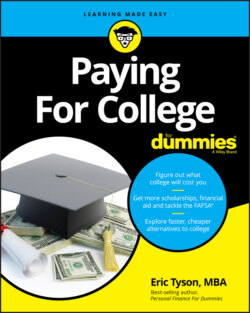Читать книгу Paying For College For Dummies - Eric Tyson - Страница 14
A brief historical overview of colleges and who completes it
ОглавлениеHigh-priced four-year college degrees are a relatively recent and not entirely attractive phenomenon. After World War II, with the GI bill (designed to help servicemen returning to society) and massive investments at the state public university systems and federal levels with the availability and promotion of Pell Grants and student loans, adults with college degrees mushroomed from just 5 percent of the adult population to more than 30 percent.
The most recent figures show that about 35 percent of U.S. adults age 25 and older have completed a four-year college degree. 48 percent of 25 to 34-year olds have a college degree. About 13 percent of all adults have completed an advanced degree — that is a master’s degree, professional degree, or a doctorate degree.
That said, here’s another and truly shocking and important to know statistic: only about 55 percent of those who enroll in a four-year college degree program actually complete it. Think about that for a moment — this means that a whopping 45 percent of those who head down that costly road end up with no credential and therefore have probably wasted their time and money. In case you’re wondering, community college is no better in that regard (although it’s a lot cheaper) as 81 percent of students who start at community college believe they will eventually earn a bachelor’s degree but in fact only 12 percent do.
These college graduation percentages highlight an important topic. Whenever you’re examining specific colleges, you should always evaluate the school’s graduation rate. Higher percentages are better, of course. If a college you’re considering has a relatively lower graduation percentage, inquire and investigate why. Is it because of a lack of on-campus housing and nearby affordable rentals? Is it because the college accepts students who are having trouble staying on track? Is it because students are uninspired by the overall education and experience they are having once on campus for a period of time?
According to a Chronicle of Higher Education analysis of U.S. Department of Education graduation rate data, overall private nonprofit colleges have a six-year graduation rate of 66 percent, public colleges graduated about 59 percent while for-profit colleges lagged far behind, graduating just 21 percent of their first-time, full-time students within six years. As another point of reference, Table 1-1 gives a short list of the ten private (non-profit), public, and for-profit colleges with the highest six-year graduation rates.
TABLE 1-1 Colleges with best six-year graduation rates
| Four-year private colleges | ||
| 1. | Yale U. | 97.4% |
| 2. | Princeton U. | 97.3% |
| 3. | Harvard U. | 96.4% |
| 4. | Dartmouth College | 95.9% |
| 5. | Harvey Mudd College | 95.9% |
| 6. | U. of Pennsylvania | 95.7% |
| 7. | Duke U. | 95.4% |
| 8. | Bowdoin College | 95.2% |
| 9. | U. of Notre Dame | 95.2% |
| 10. | Amherst College | 95.2% |
| Four-year public colleges | ||
| 1. | U. of Virginia | 94.6% |
| 2. | College of William & Mary | 92.1% |
| 3. | U. of Michigan at Ann Arbor | 91.6% |
| 4. | U. of California at Berkeley | 91.1% |
| 5. | U. of North Carolina at Chapel Hill | 90.9% |
| 6. | U. of California at Los Angeles | 90.9% |
| 7. | U. of Florida | 88.0% |
| 8. | U. of Wisconsin at Madison | 87.2% |
| 9. | College of New Jersey | 86.6% |
| 10. | U. of Maryland at College Park | 85.4% |
| Four-year for-profit colleges | ||
| 1. | Los Angeles Film School | 78.6% |
| 2. | Monroe College (N.Y.) | 73.6% |
| 3. | Pima Medical Institute at Tucson | 73.0% |
| 4. | Santa Fe U. of Art and Design | 69.6% |
| 5. | New York Film Academy at Los Angeles | 69.4% |
| 6. | SAE Expression College | 68.9% |
| 7. | Bob Jones U. | 65.6% |
| 8. | School of Visual Arts | 64.1% |
| 9. | International Business College at Fort Wayne (Ind.) | 59.3% |
| 10. | Neumont College of Computer Science | 58.8% |
Now, I must point out here something that may seem obvious. These high graduation rates, especially at the traditional non-profit colleges, shouldn’t be viewed in isolation and don’t, in and of themselves, necessarily tell you much about the educational quality of the school. Or stated another way, the schools on these lists don’t deserve all the credit for these high graduation rates! After all, these schools (at least the non-profit ones) are some of the most selective in the country so there’s a so-called selection bias going on here. These colleges only take well-prepared, high achieving students and the vast majority of these students come from families that highly value this type of educational experience. And, because these more selective colleges have so many applicants, they generally have plenty of more affluent families that can afford the high-ticket price and can afford to keep their kids in college for the duration of the four years. So, of course these students are more likely to succeed at completing college and graduating in a timely fashion.
By contrast, colleges that have more open enrollment, that take more risks on less prepared students are naturally going to have a lower graduation rate. But that doesn’t mean that some of those schools with less impressive graduation rates necessarily provide an inferior quality of education or an inability to graduate your child on time.
